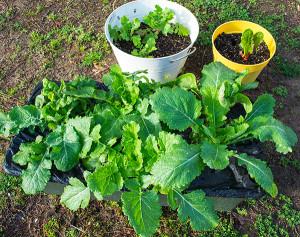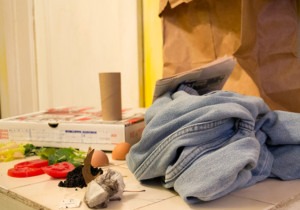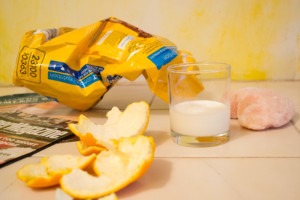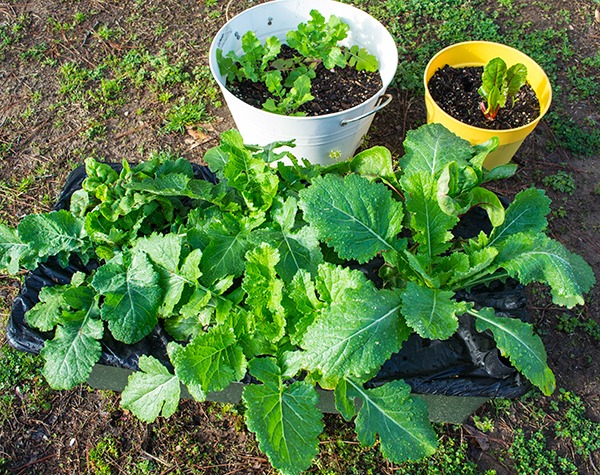“If you plant it, it will grow,” turns out to not necessarily be the case.
I’m approaching my third summer of attempting to supply our little two-person family with wholesome, organic, homegrown vegetables. My original idea was to use only the composts I created from my kitchen scraps and fall leaves. Fail. 🙁
Things grew. They did not flourish.
Reality hit me square across the face about a month after I purchased my EarthBox. The kit comes with a cool little rectangular planter, complete with good soil and proper fertilizer. Here is a photo comparing the growth with my homemade soil concoction and with the EarthBox prepared soil. My two pots, shown above, were actually planted weeks earlier. Yes, I am humbled. I must admit, I’m new at this and clearly not a prodigy.

I’ve done some research and I know creating my own good earth can be done, but it will take at least a year to build the soil. I need a little more planning and some education!
In the meantime, I’m going to have to bite the bullet and add some commercial nutrition to my depleted soil while I wait on my proper composts to mature!
So here’s the current plan. I’ll start dead leaf composting bins which will take at least a year to be usable. Small pieces of stick can go in as well. This compost is purported to be good for starting seed. I’ll keep two of these compost areas. When one is full (and it almost is), I’ll stop filling it to let it “cook”, turning it often with a pitchfork to add to the heat and discourage varmints from settling in. While it does it’s thing, I’ll start the second.
In addition, I’ll keep two food scrap heaps which will be good soil additives for plant growth. I’ll add that to my garden plots. Variety is essential in this kind of composting. Here’s the down-low.

Do use coffee grounds, tea bags, grass clippings, newspaper, unshiny cardboard, cotton clothing, wool clothing, vegetable scraps, most fruit scraps, and eggshells. My little sister always gives me lots of crap! Cow and horse manure, that is! Her in-laws have a barn full of it and aged manure is great for the garden! Do use wood ash from fires and culled plant life that has soaked in water for a week or two to the point of rotting. Layering, variety, and turning are essential. The more frequent the turning the faster the results. Once I’ve completely filled the first, again I’ll start a second bin while the first one matures.

Do NOT use citrus, dairy products, shiny paper or cardboard or meat scraps. The citrus discourages worms. Meat and dairy products are not good. Do not use charcoal ash.
While I wait on my homemade dirt, l have to purchase commercial additives. I’ll make sure of and want to share two essential tips, because I didn’t know this until very recently.
1. Use organic potting soil with living microbes
Organic potting soils contain living microbes, and this is essential for the health of your dirt. You can buy chemical fertilizers that work faster, but many choices are harsh on the dirt and destroy the organisms that keep it healthy. It is like using steroids instead of good health and hard work. You’ll be trading what you want for what you want right now! Please double check to see if what you intend to purchase is good for the environment!
2. Love coconuts!
Use of coir in lieu of peat moss is an absolute must. It’s a relatively inexpensive and sound substitute made from coconut husks. You may have to order online but it’s worth it. We ordered a compressed block of the stuff from hayneedle.com, and it arrived lickety-split! Peat moss works great, but it is not sustainable. Peatlands or peat bogs are very slow to develop. When I say slow, I’m talking about millennia. Peat bogs grow only about 1/4 inch a year at best and are, much like the rain forest, an important part of the atmosphere. They absorb much of the carbon dioxide in our air, and we need them! In the words of the writer from OrganicGardening.com, “Can a resource that renews itself this slowly ever be considered sustainable? If we balk at cutting down 500-year-old trees in old-growth forests, should we accept the extraction of 3,000-year-old sphagnum moss from peat bogs?”
So, here’s what I’ve got for now. I’ll report back soon on how my garden is growing. I hope my stumbles are helpful to folks out there that, like me, are not ‘born’ gardeners.
Next thing up! We’re envisioning a super small and productive raised bed garden plan. My coir has just arrived, and I am ready to give it a try. Wish us luck!

